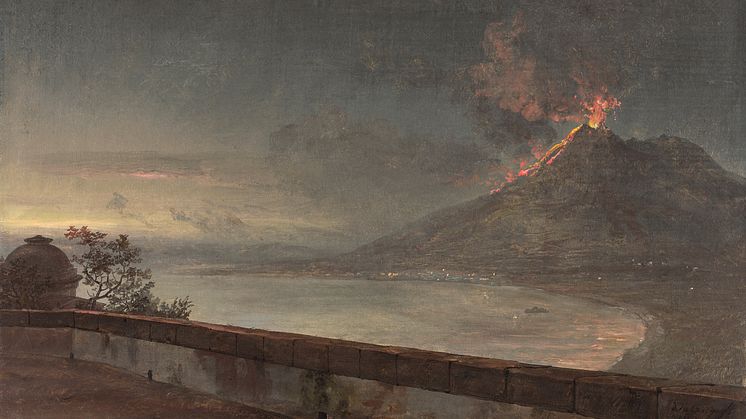
Press release -
New acquisition: View of Vesuvius from Villa Quisisana by Johan Christian Dahl
Nationalmuseum has acquired View of Vesuvius from Villa Quisisana, one of the few Italian landscapes by Johan Christian Dahl (1788–1857) still in private hands. The artist is best known for his landscapes from his native Norway, but his outdoor scenes from Italy have also attracted great interest among museums and collectors. The newly acquired painting is an important document from a particularly significant period in Dahl’s life.
Imagine it is August 1820. You have been travelling for two months. By horse and cart, by boat, and on foot. The journey has been hazardous and exhausting. A few days ago, you arrived at one of your main destinations: the Bay of Naples, with famous sights such as Vesuvius, Capri, and Naples itself. You have spent the past few days quietly relaxing as a newly arrived guest in a big house on the hillside overlooking the town of Castellammare. Your first impressions of the place are so powerful that you never want to forget them. You want to be able to conjure them up and relive them later in life.
This is the feeling that Johan Christian Dahl’s painting of the view from the roof terrace of the Villa Quisisana seems to exude. Dahl arrived at the villa on 11 August 1820 as a guest of Crown Prince Christian Frederik of Denmark. The scene from the terrace is dated five days later. Dahl spent the intervening period in the palatial villa socializing with the art-loving prince and his court and painting the view.
Dahl’s painting is special in several respects. It is too small, and too sketch-like in its execution, to have been intended for sale. However, the foreground with the wall makes this little painting seem too carefully finished to be regarded as a mere study. The most likely explanation is that Dahl intended to create a personal souvenir of his visit. What makes the motif special is firstly the dramatic effect of the erupting Vesuvius, and secondly the strong emphasis on the foreground with its wall. Without the latter, the painting could be seen purely as a study, in which the artist’s main focus was on capturing the twilight and the atmosphere. But such clear identification of the viewpoint is extremely rare in sketches. The Bay of Naples with Mount Vesuvius was certainly a popular motif, but Dahl’s precise dating of the work, 16 August 1820, makes the image seem more like a journal entry. The compact format, 20 x 30 cm, somewhat paradoxically reinforces the overpowering nature of Dahl’s personal experience of the beautiful view in the evening light, with the menacing volcanic activity in the background.
Nationalmuseum’s purchase of this work has been made possible by a generous bequest from the Wiros Fund. Nationalmuseum has no budget of its own for new acquisitions, but relies on gifting and financial support from private funds and foundations to enhance its collections of fine art and craft.
Press contacts
Carl-Johan Olsson, curator, carl-johan.olsson@nationalmuseum.se, +46 8 5195 4324
Hanna Tottmar, press officer, hanna.tottmar@nationalmuseum.se, +46 767 234632
Caption
Johan Christian Dahl, View of Vesuvius from Villa Quisisana, 1820. Photo: Cecilia Heisser/Nationalmuseum
Categories
Nationalmuseum is Sweden’s premier museum of art and design. The collections comprise older paintings, sculpture, drawings and graphic art, and applied art and design up to the present day. The museum building is currently under renovation and scheduled to open again in 2017. In the meantime, the museum will continue its activities through collaborations both in Sweden and abroad as well as temporary exhibitions at the Royal Swedish Academy of Fine Arts, Fredsgatan 12 and Nationalmuseum Design at Kulturhuset Stadsteatern in Stockholm. Nationalmuseum collaborates with Svenska Dagbladet, FCB Fältman & Malmén and Grand Hôtel Stockholm. For more information visit www.nationalmuseum.se.

